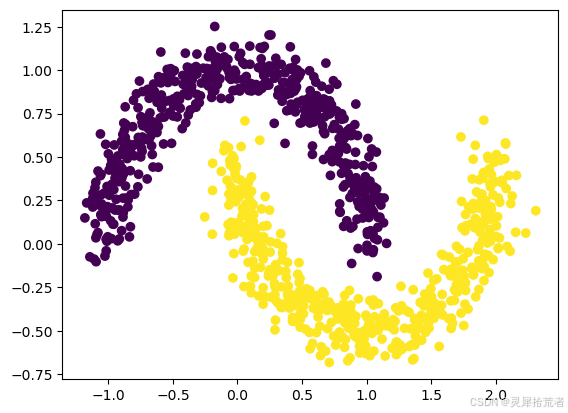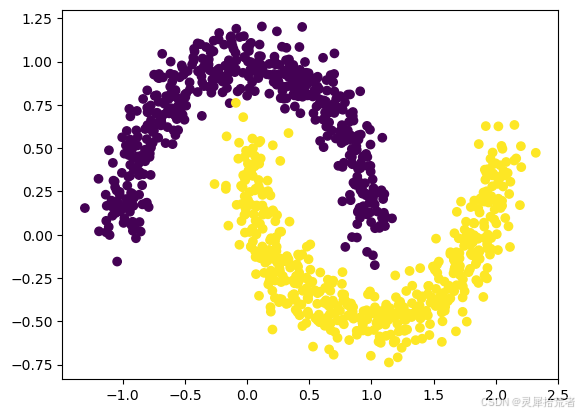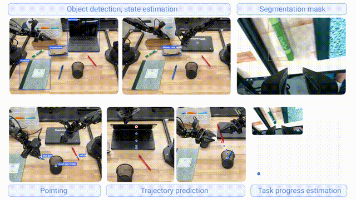【KAN】KAN神经网络学习训练营(24)——Example 3:分类
Kolmogorov-Arnold 表示定理Kolmogorov-Arnold 表示定理指出,如果 是有界域上的多元连续函数,那么它可以写为单个变量的连续函数的有限组合,以及加法的二进制运算。更具体地说,对于 光滑其中 和。从某种意义上说,他们表明唯一真正的多元函数是加法,因为所有其他函数都可以使用单变量函数和 sum 来编写。然而,这个 2 层宽度 - Kolmogorov-Arnold 表示可
一、引言
KAN神经网络(Kolmogorov–Arnold Networks)是一种基于Kolmogorov-Arnold表示定理的新型神经网络架构。该定理指出,任何多元连续函数都可以表示为有限个单变量函数的组合。与传统多层感知机(MLP)不同,KAN通过可学习的激活函数和结构化网络设计,在函数逼近效率和可解释性上展现出潜力。

二、技术与原理简介
1.Kolmogorov-Arnold 表示定理
Kolmogorov-Arnold 表示定理指出,如果 是有界域上的多元连续函数,那么它可以写为单个变量的连续函数的有限组合,以及加法的二进制运算。更具体地说,对于 光滑
其中 和 。从某种意义上说,他们表明唯一真正的多元函数是加法,因为所有其他函数都可以使用单变量函数和 sum 来编写。然而,这个 2 层宽度 - Kolmogorov-Arnold 表示可能不是平滑的由于其表达能力有限。我们通过以下方式增强它的表达能力将其推广到任意深度和宽度。,
2.Kolmogorov-Arnold 网络 (KAN)
Kolmogorov-Arnold 表示可以写成矩阵形式
其中
我们注意到 和 都是以下函数矩阵(包含输入和输出)的特例,我们称之为 Kolmogorov-Arnold 层:

其中。
定义层后,我们可以构造一个 Kolmogorov-Arnold 网络只需堆叠层!假设我们有层,层的形状为 。那么整个网络是
相反,多层感知器由线性层和非线错:
KAN 可以很容易地可视化。(1) KAN 只是 KAN 层的堆栈。(2) 每个 KAN 层都可以可视化为一个全连接层,每个边缘上都有一个1D 函数。
三、代码详解
1. 首先将问题视为回归问题(输出维度=1,MSE损失)
2. 创建双月数据集
from kan import KAN
import matplotlib.pyplot as plt
from sklearn.datasets import make_moons
import torch
import numpy as np
dataset = {}
train_input, train_label = make_moons(n_samples=1000, shuffle=True, noise=0.1, random_state=None)
test_input, test_label = make_moons(n_samples=1000, shuffle=True, noise=0.1, random_state=None)
dataset['train_input'] = torch.from_numpy(train_input)
dataset['test_input'] = torch.from_numpy(test_input)
dataset['train_label'] = torch.from_numpy(train_label[:,None])
dataset['test_label'] = torch.from_numpy(test_label[:,None])
X = dataset['train_input']
y = dataset['train_label']
plt.scatter(X[:,0], X[:,1], c=y[:,0])

3. 训练KAN模型
model = KAN(width=[2,1], grid=3, k=3)
def train_acc():
return torch.mean((torch.round(model(dataset['train_input'])[:,0]) == dataset['train_label'][:,0]).float())
def test_acc():
return torch.mean((torch.round(model(dataset['test_input'])[:,0]) == dataset['test_label'][:,0]).float())
results = model.train(dataset, opt="LBFGS", steps=20, metrics=(train_acc, test_acc));
results['train_acc'][-1], results['test_acc'][-1]
4. 自动符号回归
lib = ['x','x^2','x^3','x^4','exp','log','sqrt','tanh','sin','tan','abs']
model.auto_symbolic(lib=lib)
formula = model.symbolic_formula()[0][0]
formula
5. 这个公式有多准确?
# how accurate is this formula?
def acc(formula, X, y):
batch = X.shape[0]
correct = 0
for i in range(batch):
correct += np.round(np.array(formula.subs('x_1', X[i,0]).subs('x_2', X[i,1])).astype(np.float64)) == y[i,0]
return correct/batch
print('train acc of the formula:', acc(formula, dataset['train_input'], dataset['train_label']))
print('test acc of the formula:', acc(formula, dataset['test_input'], dataset['test_label']))
6. 然后将问题视为分类问题(输出维度=2,交叉熵损失)
7. 创建双月数据集
from kan import KAN
import matplotlib.pyplot as plt
from sklearn.datasets import make_moons
import torch
import numpy as np
dataset = {}
train_input, train_label = make_moons(n_samples=1000, shuffle=True, noise=0.1, random_state=None)
test_input, test_label = make_moons(n_samples=1000, shuffle=True, noise=0.1, random_state=None)
dataset['train_input'] = torch.from_numpy(train_input)
dataset['test_input'] = torch.from_numpy(test_input)
dataset['train_label'] = torch.from_numpy(train_label)
dataset['test_label'] = torch.from_numpy(test_label)
X = dataset['train_input']
y = dataset['train_label']
plt.scatter(X[:,0], X[:,1], c=y[:])
8. 训练KAN模型
model = KAN(width=[2,2], grid=3, k=3)
def train_acc():
return torch.mean((torch.argmax(model(dataset['train_input']), dim=1) == dataset['train_label']).float())
def test_acc():
return torch.mean((torch.argmax(model(dataset['test_input']), dim=1) == dataset['test_label']).float())
results = model.train(dataset, opt="LBFGS", steps=20, metrics=(train_acc, test_acc), loss_fn=torch.nn.CrossEntropyLoss());![]()
9. 自动符号回归
lib = ['x','x^2','x^3','x^4','exp','log','sqrt','tanh','sin','abs']
model.auto_symbolic(lib=lib)
formula1, formula2 = model.symbolic_formula()[0]
formula1![]()
formula2 ![]()
10. 这个公式有多准确?
# how accurate is this formula?
def acc(formula1, formula2, X, y):
batch = X.shape[0]
correct = 0
for i in range(batch):
logit1 = np.array(formula1.subs('x_1', X[i,0]).subs('x_2', X[i,1])).astype(np.float64)
logit2 = np.array(formula2.subs('x_1', X[i,0]).subs('x_2', X[i,1])).astype(np.float64)
correct += (logit2 > logit1) == y[i]
return correct/batch
print('train acc of the formula:', acc(formula1, formula2, dataset['train_input'], dataset['train_label']))
print('test acc of the formula:', acc(formula1, formula2, dataset['test_input'], dataset['test_label']))
四、总结与思考
KAN神经网络通过融合数学定理与深度学习,为科学计算和可解释AI提供了新思路。尽管在高维应用中仍需突破,但其在低维复杂函数建模上的潜力值得关注。未来可能通过改进计算效率、扩展理论边界,成为MLP的重要补充。
1. KAN网络架构
-
关键设计:可学习的激活函数:每个网络连接的“权重”被替换为单变量函数(如样条、多项式),而非固定激活函数(如ReLU)。分层结构:输入层和隐藏层之间、隐藏层与输出层之间均通过单变量函数连接,形成多层叠加。参数效率:由于理论保证,KAN可能用更少的参数达到与MLP相当或更好的逼近效果。
-
示例结构:输入层 → 隐藏层:每个输入节点通过单变量函数
连接到隐藏节点。隐藏层 → 输出层:隐藏节点通过另一组单变量函数
组合得到输出。
2. 优势与特点
-
高逼近效率:基于数学定理,理论上能以更少参数逼近复杂函数;在低维科学计算任务(如微分方程求解)中表现优异。
-
可解释性:单变量函数可可视化,便于分析输入变量与输出的关系;网络结构直接对应函数分解过程,逻辑清晰。
-
灵活的函数学习:激活函数可自适应调整(如学习平滑或非平滑函数);支持符号公式提取(例如从数据中恢复物理定律)。
3. 挑战与局限
-
计算复杂度:单变量函数的学习(如样条参数化)可能增加训练时间和内存消耗。需要优化高阶连续函数,对硬件和算法提出更高要求。
-
泛化能力:在高维数据(如图像、文本)中的表现尚未充分验证,可能逊色于传统MLP。
-
训练难度:需设计新的优化策略,避免单变量函数的过拟合或欠拟合。
4. 应用场景
-
科学计算:求解微分方程、物理建模、化学模拟等需要高精度函数逼近的任务。
-
可解释性需求领域:医疗诊断、金融风控等需明确输入输出关系的场景。
-
符号回归:从数据中自动发现数学公式(如物理定律)。
5. 与传统MLP的对比

6. 研究进展
-
近期论文:2024年,MIT等团队提出KAN架构(如论文《KAN: Kolmogorov-Arnold Networks》),在低维任务中验证了其高效性和可解释性。
-
开源实现:已有PyTorch等框架的初步实现。
【作者声明】
本文分享的论文内容及观点均来源于《KAN: Kolmogorov-Arnold Networks》原文,旨在介绍和探讨该研究的创新成果和应用价值。作者尊重并遵循学术规范,确保内容的准确性和客观性。如有任何疑问或需要进一步的信息,请参考论文原文或联系相关作者。
【关注我们】
如果您对神经网络、群智能算法及人工智能技术感兴趣,请关注【灵犀拾荒者】,获取更多前沿技术文章、实战案例及技术分享!
更多推荐
 已为社区贡献12条内容
已为社区贡献12条内容









所有评论(0)